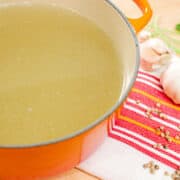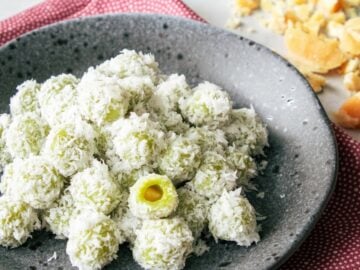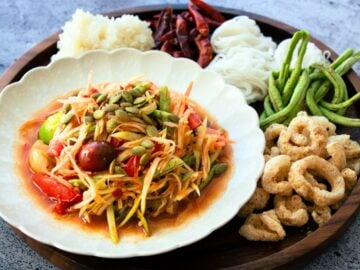The importance of a good stock cannot be overstated, especially when making a soup, stew, or sauces. I am so passionate about this I even wrote about it in my cookbook. And considering how easy it is (almost no effort, it just takes some time!) there should be no reason why you shouldn't!
When cooking Asian food there is an even bigger reason why you should make your own stock, and that is because Western style store-bought stock may have a flavours of aromatics and herbs that don't work as well with Asian food. This recipe is a neutral-flavoured chicken stock recipe that will work with Asian recipes, including all Thai dishes.
Storage tip: Trust me, make a bunch, freeze them in bags (in small amounts for convenient thawing), and you'll be glad you did! When freezing I like to divide it into no larger than 2-cup portions and put them into the medium size freezer bags. Lay them flat to freeze so you get a thin disk that is quick to thaw. Make sure to label the bag so you don't forget what it is!
When thawing, SOMETIMES the freezer bag may have a little hole in it especially if it's been in the freezer for a while, rubbing up against other frozen stuff, so make sure to place the stock bag inside a bowl or a pot to thaw, so if it does leak, the stock is still contained! And you can refreeze any stock you don't end up using without any problems.
Want to save this recipe?
Here are some recipes you can use this chicken stock for:
- Tom Ka Gai - Coconut Galangal Chicken Soup
- Tom Yum Chicken Soup
- Green chicken curry
- Red chicken curry with kabocha squash
- You can also do a search for "chicken stock" on the site and all relevant recipes will show up!
Watch The Full Video Tutorial!
All my recipes come with step-by-step video tutorials with extra tips not mentioned in the blog post, so make sure you watch the video below to ensure success - and if you enjoy the show, please consider subscribing to my YouTube channel. Thank you!

Thai-Style Chicken Stock น้ําสต๊อกไก่
- Yield: Makes about 6 cups
Ingredients
- 2 lb chicken bones, remove any big chunks of fat you can see
- 3 L water
- 5 cloves garlic, smashed
- 4 inch section daikon, peeled, or use 1 onion instead (or use both like I did!)
- 2-3 cilantro roots, or about 8 stems
- ¼ teaspoon white peppercorns, crushed just until broken
- 2 stalks of lemongrass, top half only, cut into chunks (optional, only if you’ve got some handy)
Note: When peeling daikon, peel a few layers off until the colour turns from bright, opaque white to a bit darker, more translucent white. I find the outer layer of the daikon a bit bitter.
Want to save this recipe?
Instructions
Add bones to a big pot and cover with the water. Bring to a simmer over high heat, then once bubbling, reduce the heat to maintain a gentle simmer. Simmer bones for about 45 minutes.
Skim off scum, foam and fat that has floated to the top.
Add all the remaining ingredients then simmer for another hour.
Fish out all the bones and aromatics with a wire skimmer or strain the stock through a colander. The stock is now ready to use!
Tip: Waste not! There is often a lot of meat left on chicken bones, so if you want, you can pull off the meat from the bones after removing them from the stock, and you can throw it into soups, chili, stir-fries, fried rice...anything! The meat will be rather bland so make sure you add it to something that will have a lot of flavourful sauce added to it.





Jess says
Hi Pai! Just wondering whether you have any uses for the leftover boiled daikon after the stock is finished?
Pailin Chongchitnant says
You can totally just cut it up and add it to soups, stews or curries 🙂 Might be a bit bland, though.
Doug says
Hi, I’m curious as to the lack of salt. Is the idea to keep it blander to be less intrusive?
Pailin Chongchitnant says
This chicken stock recipe is intended to be an ingredient for using in other dishes, not to be consumed as is. I don't add salt because that would interfere with the recipe that I'll be using it in, which might call for fish sauce, soy sauce, or any number of other salty ingredients. But if you're going to drink the chicken stock as is, please do season it with salt/soy sauce/fish sauce or any other salty ingredients!
Lyle says
Greetings, we use this recipe exclusively for your chicken noodle soup and freeze it in single meal portions. Is it ok to add the fish sauce, sugar and soy sauce with the other aromatics? Or will it affect those flavor, should those things only be added when preparing the soup?
Amy says
I have been enjoying your content so much, Pai (and Adam)! It has inspired me to try cooking Thai food at home myself (I found it pretty intimidating in the past). I have learned so much, and I am grateful to you!
I was wondering if you could give any more specificity on the amount of Daikon I need for the stock? I went to the Asian market in my town, and they had daikon, and I knew I only needed a bit, and there were huge ones, but I got one that's about the size of a cucumber in circumference and length. Do I still only need 4 inches, or would I need more? I'm assuming yours was fatter than mine, so 4 inches of yours would be more than 4 inches of mine? Any help is much appreciated. I've never made eastern style stock before (or any stock actually, so this will be a first) and I'm kind of nervous. Also, (I know this is unrelated to the stock, so please forgive me for putting it here. I just imagine it's easier for you to respond to one message, rather than two on two separate pages), I am quite intimidated by shrimp paste. Is it going to make my dish taste like shrimp (or krill technically)? Or will it just make things super savory/umami? I'm not a big seafood fan, so I don't want all my curry to taste like the sea, but if it's just making it umami (as I assume fish sauce does, I haven't used it yet either) that's ok. Would you recommend I omit the shrimp paste if I want to avoid a seafood flavor, or will it be ok? Thanks so much again, ~Amy <3
Adam from HTK says
Hi Amy, and thanks!! 🙂 She's in Thailand at the moment so it might take a little while for her to get back to you, but I've let her know about your questions 🙂 Cheers and have fun! Adam
Pailin Chongchitnant says
Hi Amy! Thanks for watching! Re: the daikon, your daikon sounds unusually skinny, so I'd use 8 inches of it. However, with stocks, the amount of veg does not need to be precise at all, so going forward don't worry about amounts of anything. I give amounts just to provide a guideline. People in restaurants often use the stock pot as a place to put odds and ends of vegetables they have on hand! Shrimp paste in curry will not make it taste shrimpy, it's a small amount that will add umami, so it's fine to use it!
Sean says
Hi Pai, could I add some kaffir lime leaves to the stock (if I can find them)? If yes, how many leaves would you add? Also, what about any additional spices, such as star anise? Thank you!
Pailin Chongchitnant says
Hi Sean, you can add any herbs or spices you want in theory, but since this is a basic stock to be used in various dishes, I tend to keep it mild to keep its versatility. I don't necessarily want everything that I add this stock to to have kaffir lime flavour or star anise flavour, so I wouldn't put those in...but if you have a favourite flavour you want in everything, then by all means!
Yenni says
Really good chicken stock recipe. Its really versatile. I keep a batch in my freezer and its my go to stock recipe. Weekday dinner is sorted by just defrosting the stock, put any kind of noodle, protein and vege and voila dinner is served. Thank you Pai Lin. I love your great work. Keep it up.